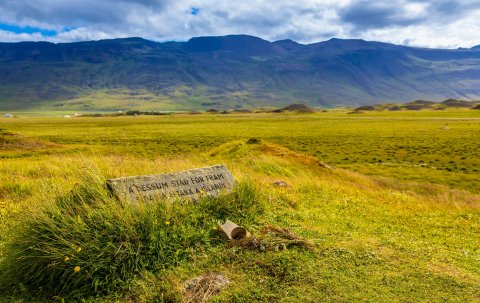Þrístapar - The last execution in Iceland

Have you heard about the last execution in Iceland?
Listen to a story from Magnús Ólafsson where he talks about when his father and grandfather dug up the bones of Agnes and Friðrik.
In the player below you can listen to the story as well as it is available in writing further down the page.
The story is read by Vilhjálmur Bermann Bragason.
"Agnes Magnúsdóttir and Friðrik Sigurðsson had been sentenced to death for the murder of two men in the night of 14 March 1828, Natan Ketilsson, farmer at Illugastaðir, and Pétur Jónsson from Geitaskarð. The district commissioner, Björn Blöndal, had a place called Þrístapar prepared for the execution. He chose it because it was elevated and easily accessible, so that 150 people could gather around and witness the event. The spectators were asked to stand in three lines and encircle the place of execution and no one was allowed to look away. The farmers who were unable to attend had to send farmhands in their stead.
Friðrik rode to the execution on his horse, dismounted it and greeted the onlookers, district commissioner Blöndal and Guðmundur, the executioner. Friðrik was a young man, not even 20 years old, and he arrived singing to his own execution. Guðmundur performed his duty and after one strike Friðrik’s head rolled off. The spectators probably stood so close that they were splattered with his blood.
Agnes was in a completely different state of mind. She was downhearted when she arrived and felt as if she had not been given the chance to speak up for herself and protest her treatment. She left this world feeling that her case was unresolved. She was very discontent when she died. She may still be discontent, to this day, and of the opinion that no one was willing to listen to her while she was alive. In 1828, poor maids had no advocates. They were supposed to sit and stand according to their master’s command. One has to put oneself in their shoes—what is a young woman to do when trapped as a housemaid with men who control absolutely everything? It’s impossible to get away. It is known that both Agnes and Sigríður, another maid at the same farm, had tried to escape Illugastaðir. But at that time, the masters held the absolute power, and the maids were insignificant.
In that time, criminals could not be buried in sacred ground, so they were buried close to the place of execution. In compliance with the law, their heads were put on spikes. But the following morning, the heads were gone. No one knew what had happened to the heads. But the fact was that Guðrún, the housewife at Þingeyrar, had sent a young farmhand to collect the heads and bury them in a grave in the Þingeyrar cemetery, which had recently been dug. She found the thought of leaving the heads unburied to be unbearable.
Many years later a man came to see my grandfather, who lived at Sveinsstaðir where Þrístapar is located. He said that he had been given permission to dig up the remains of Agnes and Friðrik and asked my grandfather to help him. My grandfather told him that this would be difficult as he didn’t know the exact location of the graves. He had lived at Sveinsstaðir his whole life and had often thought about the graves but didn’t know where they were.
The man said that he had information about the location of the graves. He had been sent by Agnes Magnúsdóttir herself and that she had delivered a message through a woman by psychography. The man added that Agnes had revealed that the farmhand from Þingeyrar had truly gone out the night after the execution but had lost his courage and instead of carrying the heads the 6-km-distance to Þingeyrar, he had buried them close to the coffins. “He was unable to remove my head from the spike, so he broke it,” she elaborated in the psychography.
They started digging: The man, my granddad and my dad, who was 19 at the time. It only took them 15 minutes to find the graves by ramming an iron pole into the ground. They found pieces of wood and underneath them, the bones of Agnes and Friðrik, which had been inside the wooden coffins. When they continued digging, they found two skulls, and next to one of them, a 10-cm-long wooden stick. Their remains were excavated and buried in sacred ground at Tjörn on Tjörnes, 104 years later.
It is remarkable how Agnes made sure to have her and Friðrik’s remains dug up; how she delivered the message through a woman by psychography, stating that she would like their remains to by buried in holy ground. Agnes even pointed out the location of their heads, close to the place of execution. Even the greatest sceptics who refuse to believe in life after death find it hard to object in light of this overwhelming evidence."